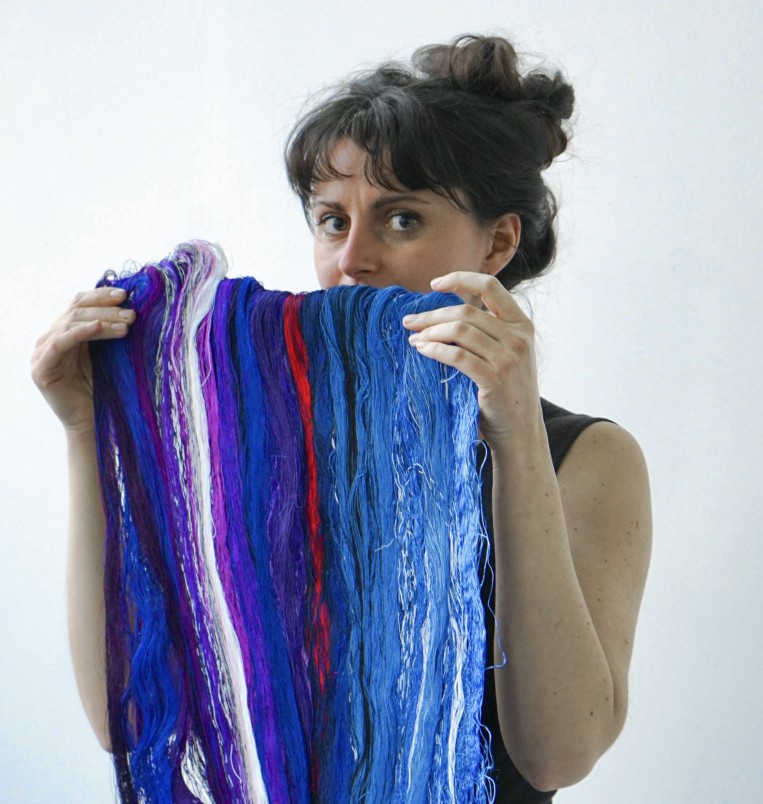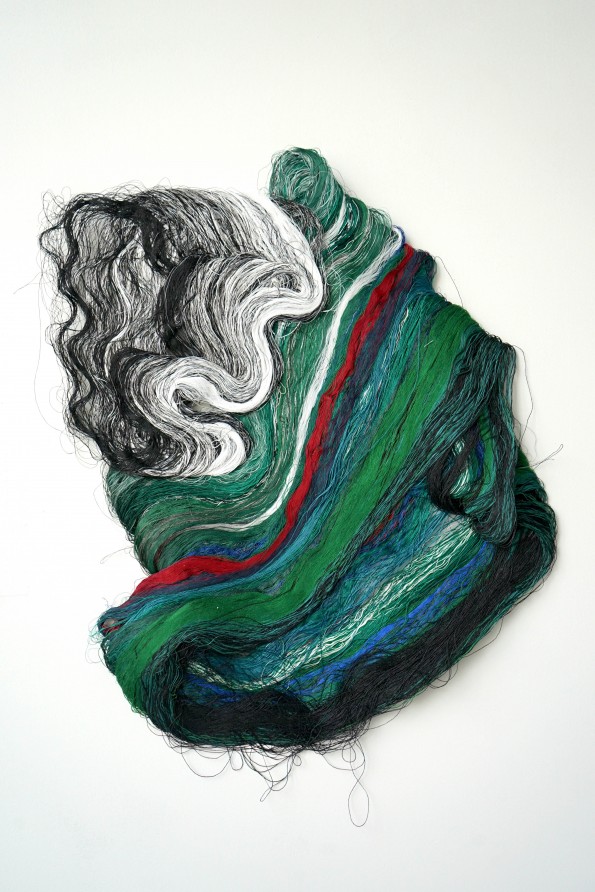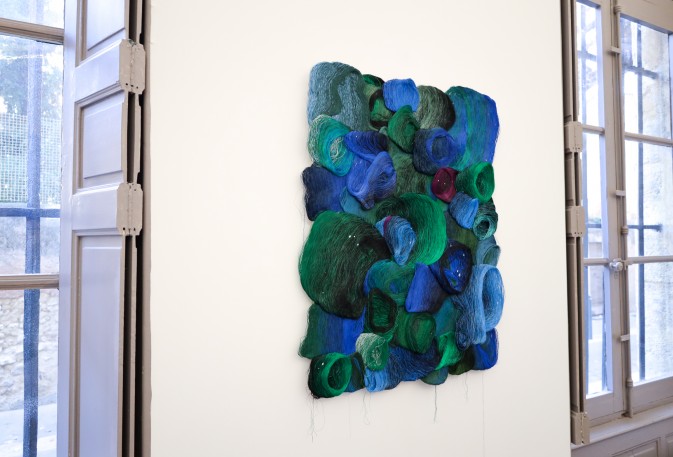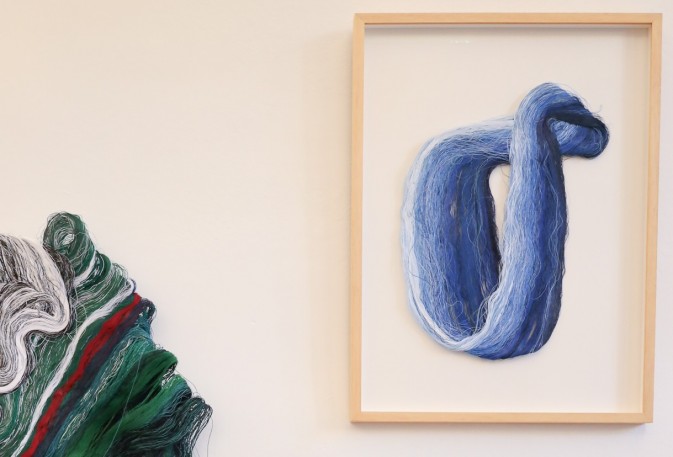Mémoire Désir


Jolivet has lived and worked in Paris for 12 years and combines working for haute couture clients with personal projects at her workshop. She has spent time in Italy where dye baths, marble floors, factories where cast iron and oil are used alongside some of the most delicate materials, are all experiences that have profoundly marked her work.
Thread is the principal tool of her work. She uses yarn as a pigment, diluting or densifying at will to create textile paintings with abstract compositions. Mixing the yarns allows her to create nuances in the same way a painter produces their own colours. Abandoning traditional embroidery, where the thread is often no more than the basis for different components, her speciality is creating works from the thread itself.
As a contemporary artisan, her dream is to create a dialogue between this medium and other works of art and materials such as wood, marble and metal, helping to creating places and objects that will highlight the beauty of handmade work for centuries to come.
Born in 1990, Solenne Jolivet graduated from ESAA Duperré and the Institut Français de la Mode. She started her career buying and producing materials, joining Hermès before becoming a full-time embroiderer. She has since participated in a number of exhibitions and residencies, developing her personal vision of contemporary embroidery.
- What made you want to become an embroidery artist?
I started embroidery when I was 11 years old. I was bored and my mother gave me a piece of embroidery canvas, a needle and some red thread. I still remember the first lines of crosses I made. I think I discovered the feeling of embroidery, even though I would already draw. At a certain point these two practices merged, having difficulty choosing between the two, although during the first years my embroidery work was very classical. It was really when I entered the Diplôme des Métiers d'Art that I was able to experiment and develop my own approach. My Higher Diploma of Applied Arts also allowed me to go beyond the technique, to develop the technique known as "Atolls": a mass of threads rolled up, then folded, starched, ironed and glued.
During my Diplôme des Métiers d'Art, convinced that I wanted to become an embroiderer, I did an internship in an embroidery workshop for the Circus. I hated this internship, what I had to do there (it was more like waitressing) and the atmosphere. I then chose to branch out and become a Materials Buyer through the IFM, never completely putting embroidery aside. When I arrived at Hermès, age 26, in my dream job (Fabric Development Manager), I quickly realised that embroidery was my true vocation and that I would be much happier doing it on a daily basis, which has been the case for the past 6 years.
- How do you think your work has evolved over the years? How do you think it could change in the future?
I did a Diplôme des Métiers d'Art textiles and I already wanted to work only with thread. I think that I am gradually looking for a different way of working with thread, which echoes other textile techniques such as weaving, felting and embroidery. My research subject is the idea of making a textile surface, by inventing new processes, and to have a transversal approach between textiles, drawing, sculpture and painting.
I don't know how my work will evolve, but I can't wait to look back in 5 years, 10 years, 20 years. I can already see how far I've come since my first thoughts, my first pieces, and I tell myself that I didn't imagine at the time what my work would be like today. I think that the evolution of an artist comes from their deepest convictions, from the identified quest, and also from numerous experiments that gradually become a refined style and identity.
- If you had to choose a person who inspires you, who would it be and why?
One of my favourite artists is Katharina Grosse who I would love to meet and present my work. She is a German artist who has made a name for herself in the grand use of colour, disrupting the scale of a place through the action of colour. She creates new worlds where codes are completely overturned. I find this brilliant, powerful, provocative and very visually impactful.
- How did you get the idea to put thread at the heart of your work and not embroidery?
I have never had any interest in stones, rhinestones, sequins and sequins, it just doesn’t interest me! Which is great by the way, because when I work at my customers', that's what I use mostly as an embroiderer, so for me there exists two worlds: the customers' and what I do in the workshop. On the other hand, I am fascinated by threads, embroidery with thread which exists everywhere, the techniques, the diversity of languages and which exist. The needle was invented 15,000 years ago, it's really fascinating, it was a very precursory tool for transmission and writing. It's a bit like a tool, which is used to assemble a garment but also to write on it. And each person has their own, I was able to observe this with students who had never practised embroidery during a workshop. In Haute Couture embroidery, for example, the thread is mainly used to fix elements. I wanted to use only the thread to reveal its potential. To be as close as possible to the raw material. I think that my visits to subcontractors in Italy influenced me a lot.
The idea with my pieces is to challenge and surprise, because from a distance you can imagine a material other than yarn. The thread is the zero point of my work, just like the weaver or the lacemaker. I simply show a different system of assembly. It's just like in cooking: the same ingredient can give 1000 different results. The small paintings are made with the lunéville hook technique, which is normally used to attach sequins, and which I have modified so that I work only with the thread, as if I were drawing with a pen.
- How have your years working for Hermès influenced your work?
This is a very interesting question! I don't know exactly how to answer, but I remember this period as a model of organisation, precision and efficiency, memories of a corporate life that I use as often as possible in my own entrepreneurial life! I still feel close to Hermès in many ways: the beauty of the materials, the sense of travel and curiosity, the rigorous craftsmanship... It was a great experience and helped me to assert myself professionally.
I am not yet hugely comfortable identifying my sources of inspiration. I have visions of what I want to do, but without necessarily having done any research beforehand, so my work can be very varied, with a printmaker's approach, as well as a visual artist's approach. I may be trying to appeal to different audiences, but I think it's also important to trust yourself and do what you think is right as an artist, even if a few months or years later you devalue the very pieces that you make - you will progress.
- Your work is very colourful. How do you choose the palette for your work?
For my latest series in orange-red tones, I wanted to make a counterpoint to the colours associated with arts and crafts and luxury, which are often in beige, cream, metal, gold, etc. (which are tones that I love and that I want to work on in my next big piece for an exhibition at Le Meurice in January 2023). In hindsight I find these tones much too strong, they don't really embody what I want to go towards. Maybe I had to do them to realise that! I'm not done with colour, I'm very attracted to strong modes of expression. But I also want to make pieces that are perhaps less strong, that can correspond to clients who are attentive to materials and craftsmanship. It's a search for balance that is in its infancy. In any case, I try to allow myself everything on an aesthetic level. If I want to make a piece, and I believe in it, then I trust that it will be part of my body of work.

